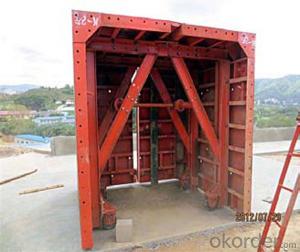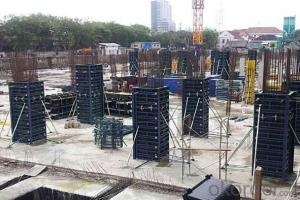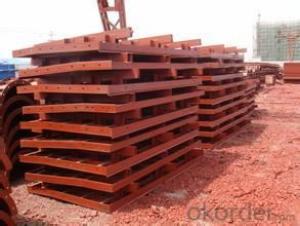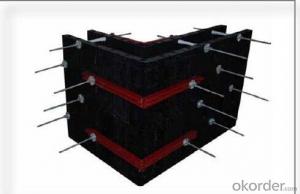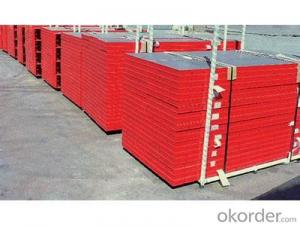Formwork Steel Props System with High Quality
- Loading Port:
- Tianjin
- Payment Terms:
- TT OR LC
- Min Order Qty:
- 28 m.t
- Supply Capability:
- 1000 m.t/month
OKorder Service Pledge
OKorder Financial Service
You Might Also Like
Formwork Steel Props System with High Quality
Product pictures:
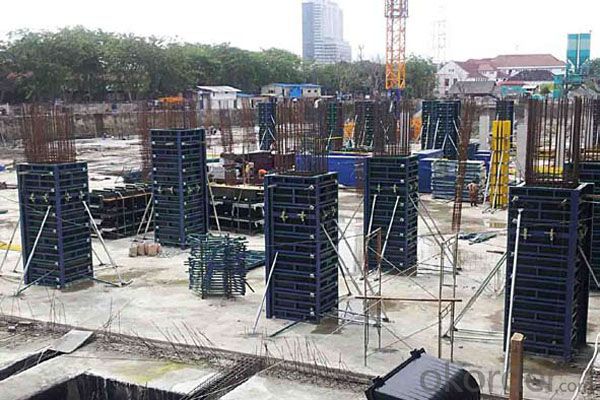
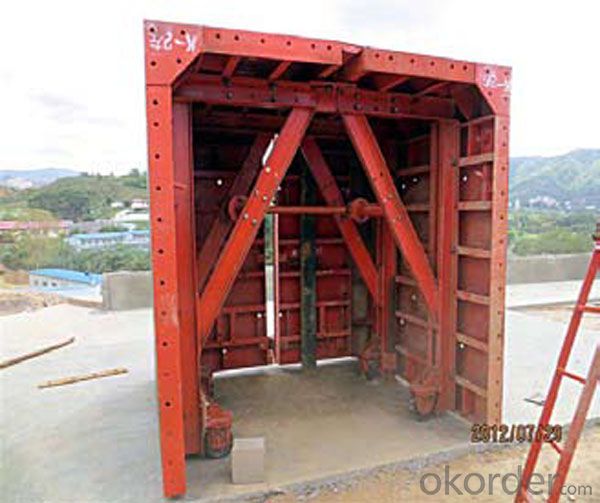
Product description:
Name: | RingLock Scaffold System |
Category: | Scaffolding System |
Material: | Steel (Q235/Q345) |
Size: | D48*3.25mm, etc |
Surface: | Electro Galvanized, Hot Dipped Galvanized, Painted, Powder Coated |
Component: | Standard, Ledger, Diagonal Brace, Bracket, Base Jack, U Head Jack, Etc. |
Application: | Slab Support, Staircase, Stage Plateforms, Bridge Support, Mobile Tower, etc. |
Manufacturer: | OEM is Available |
Items or goods can be manufactured according to your standards. | |
Advantage
* Good loading capacity
* Easy to assemble and dismantle
* Excellent quality for formwork & scaffolding with wide choices
Other scaffolding & formwork products:
(1) Scaffolding System:
(2) Scaffolding Frame & Accessories:
(3) Scaffolding Couplers/Clamps:
(4) Formwork System Scaffolding & Accessories:
Company introduce and advantages:
1. A state-owned company, prestige fi rst.
2. One of Fortune 500 companies in the world. No. 5 in the building material fi eld.
3. Six Sigma strategy , which means no more than 3.4 defects existing among one million of error
possibilities.
4. In line with the business, we launched E-business platform Okorder.com.
5. We are highly recognized by our business partners and clients all over the world and has obtained rapid
development under the spirit of win-win.
FAQ
Why Us?
We are one of the largest construction materials suppliers in China.
We own professional manufacturers with powerful producing capacity.
Extensive and comprehensive quality control system
Excellent products with competitive prices.
Efficient services in pre and after sale.
Full energy with affluent experience team.
- Q:What are the different types of formwork systems that can be used in conjunction with steel frame formwork?
- There are various formwork systems available that can be used alongside steel frame formwork. These include: 1. Timber formwork: Timber formwork is widely used and involves using timber boards or plywood to create the formwork structure. It is versatile, cost-effective, and easy to work with, making it suitable for a range of concrete structures such as walls, columns, beams, and slabs. 2. Aluminum formwork: Aluminum formwork is a lightweight and durable system consisting of interconnected aluminum panels. It is known for its high strength-to-weight ratio, allowing for faster construction and reduced labor costs. This type of formwork is commonly used for repetitive structures like residential buildings and commercial complexes. 3. Plastic formwork: Plastic formwork is gaining popularity due to its versatility and ease of use. It is made of lightweight and durable plastic panels that can be easily assembled and disassembled. Plastic formwork is suitable for various concrete structures, including walls, columns, and slabs. It offers advantages such as lower labor costs, reduced waste, and improved construction speed. 4. Fiberglass formwork: Fiberglass formwork is lightweight and strong, made of fiberglass panels capable of withstanding high concrete pressures. It is suitable for different concrete structures, including walls, columns, beams, and slabs. Fiberglass formwork offers benefits such as easy handling, reduced labor costs, and improved construction speed. 5. Modular formwork: Modular formwork involves using standardized components to create different formwork configurations. It can be integrated with steel frame formwork by combining the steel frames with the modular components. Modular formwork is highly flexible and adjustable to meet various construction requirements. It is suitable for complex structures and can be reused, making it cost-effective. In summary, these formwork systems offer advantages such as versatility, cost-effectiveness, ease of use, and increased construction speed. The choice of formwork system will depend on factors like project requirements, budget, and timeline.
- Q:Can steel frame formwork be used for hospitality and tourism facilities construction?
- Construction of hospitality and tourism facilities can indeed utilize steel frame formwork. This construction technique, known for its versatility and durability, offers numerous advantages for building projects. Its ability to provide a strong and stable structure is particularly valuable for hospitality and tourism facilities, which often necessitate expansive open spaces and multiple floors. The utilization of steel frame formwork allows for flexibility in both design and construction. Architects and engineers can create distinctive and appealing structures that cater specifically to the needs of hospitality and tourism facilities. Furthermore, this construction technique enables faster construction times, as the steel frame can be pre-fabricated off-site and easily assembled on-site. Consequently, construction time is reduced, and disruption to the surrounding area is minimized. Moreover, steel frame formwork exhibits exceptional resistance to fire, moisture, and pests. This makes it an ideal choice for hospitality and tourism facilities that must comply with stringent safety and regulatory standards. Additionally, it provides excellent sound and thermal insulation, ensuring a comfortable and pleasant environment for guests. To summarize, steel frame formwork is a suitable construction method for hospitality and tourism facilities. Its strength, flexibility, durability, and other benefits render it an attractive option for building projects within this sector.
- Q:Can steel frame formwork be used for suspended slabs?
- Yes, steel frame formwork can be used for suspended slabs.
- Q:How does steel frame formwork handle the placement of façade elements and architectural features within the concrete structure?
- Steel frame formwork is a versatile and efficient method for handling the placement of façade elements and architectural features within a concrete structure. This formwork system consists of steel frames that are pre-engineered to specific dimensions and can be easily assembled and disassembled. When it comes to placing façade elements such as windows, doors, and cladding, steel frame formwork provides a sturdy and reliable support system. The frames are designed to withstand the weight and pressure of these elements during the concrete pouring process. This ensures that the façade elements remain in their intended positions and are not displaced or damaged during construction. Architectural features, such as decorative panels, cornices, and intricate designs, can also be easily accommodated using steel frame formwork. The frames can be customized to match the desired shape, size, and contours of these features. This allows for precise and accurate placement of architectural elements within the concrete structure. Furthermore, steel frame formwork offers flexibility in terms of adjustments and modifications. As the frames are easily assembled and disassembled, any changes or alterations to the placement of façade elements or architectural features can be easily accommodated. This ensures that the final concrete structure meets the design requirements and architectural vision. In addition to its handling capabilities, steel frame formwork also provides other benefits such as durability, reusability, and cost-effectiveness. The steel frames can withstand multiple uses, reducing the need for frequent replacements. This not only saves time and money but also minimizes waste and promotes sustainable construction practices. Overall, steel frame formwork is an ideal solution for handling the placement of façade elements and architectural features within a concrete structure. Its strength, flexibility, and efficiency make it a preferred choice for construction projects that require precise and reliable positioning of these elements.
- Q:Can steel frame formwork be used for both horizontal and vertical applications?
- Yes, steel frame formwork can be used for both horizontal and vertical applications. Its sturdy construction and adjustable features make it suitable for various types of concrete structures, allowing for efficient and flexible formwork solutions.
- Q:How does steel frame formwork contribute to better concrete consolidation around reinforcement?
- Steel frame formwork contributes to better concrete consolidation around reinforcement in several ways. Firstly, the rigid steel frame provides stability and support to the formwork, ensuring that it maintains its shape and position during the pouring and curing process. This prevents any displacement or deformation that could lead to inadequate consolidation around the reinforcement. Secondly, the steel frame formwork typically incorporates various features such as tie rods, adjustable clamps, and brackets that enable precise alignment and positioning of the formwork. This allows for accurate placement of the reinforcement, ensuring that it is properly embedded within the concrete and achieving optimal consolidation. Additionally, steel frame formwork provides a smooth and even surface, without any gaps or voids, for the concrete to flow and consolidate around the reinforcement. This eliminates the risk of honeycombing or poor compaction, which can compromise the structural integrity and durability of the concrete. Furthermore, the steel frame formwork system often includes vibration mechanisms or provisions for external vibrators. These tools help to further enhance concrete consolidation by removing any trapped air bubbles and ensuring that the concrete fully surrounds and encapsulates the reinforcement, resulting in a stronger and more durable concrete structure. Overall, the use of steel frame formwork in concrete construction plays a crucial role in achieving better concrete consolidation around reinforcement, ultimately leading to improved structural performance and longevity of the concrete elements.
- Q:What are the common material specifications for steel frame formwork components?
- Steel frame formwork components typically utilize high-quality structural steel, such as mild steel or alloy steel, as the common material specifications. These materials are renowned for their robustness, endurance, and resistance against wear and tear. To construct the main frame, steel tubes or channels are commonly employed, varying in thickness and dimensions based on the design requirements and load-bearing capacity. These tubes or channels are frequently fused together, forming a solid structure capable of withstanding the pressure and weight of the poured concrete. The formwork surface is typically composed of steel plates or sheets, ranging in thickness from 3mm to 6mm. These plates are often reinforced with stiffeners or ribs to enhance their rigidity and prevent deformation or bending under the concrete's weight. Similarly, clamps, connectors, and brackets, which are other components of steel frame formwork, are typically fashioned from steel. These smaller elements are typically manufactured using steel rods, bars, or plates, ensuring their ability to securely hold the formwork intact and endure the forces exerted during the concrete pouring and curing processes. Ultimately, the selection of materials for steel frame formwork components is based on their capacity to provide structural integrity, dimensional stability, and resistance to corrosion and damage. Employing high-quality steel with appropriate specifications guarantees an efficient and secure formwork system capable of supporting the concrete during construction.
- Q:Steel frame wood template defects
- First of all, this combination is rare, aluminum and aluminum alloy template more.
- Q:Can steel frame formwork be used in areas with limited space for storage?
- Indeed, areas with limited storage space can utilize steel frame formwork. Its versatility and compactness are well-known, rendering it appropriate for projects with restricted storage capacity. Unlike conventional formwork systems, steel frame formwork can be effortlessly disassembled and reassembled, enabling efficient utilization of storage space. Furthermore, its lightweight nature and ease of transportation enhance its suitability for areas with limited storage capability. In summary, steel frame formwork proves to be a pragmatic and flexible solution for construction projects in confined spaces.
- Q:Can steel frame formwork be used for concrete stairs?
- Yes, steel frame formwork can be used for concrete stairs. Steel frame formwork is a versatile and durable system that can be customized to suit various construction needs, including the construction of stairs. It offers several advantages for constructing concrete stairs, such as high strength, stability, and the ability to create complex shapes and designs. Steel frame formwork provides a reliable and efficient solution for constructing concrete stairs, ensuring a strong and long-lasting structure.
1. Manufacturer Overview |
|
|---|---|
| Location | |
| Year Established | |
| Annual Output Value | |
| Main Markets | |
| Company Certifications | |
2. Manufacturer Certificates |
|
|---|---|
| a) Certification Name | |
| Range | |
| Reference | |
| Validity Period | |
3. Manufacturer Capability |
|
|---|---|
| a)Trade Capacity | |
| Nearest Port | |
| Export Percentage | |
| No.of Employees in Trade Department | |
| Language Spoken: | |
| b)Factory Information | |
| Factory Size: | |
| No. of Production Lines | |
| Contract Manufacturing | |
| Product Price Range | |
Send your message to us
Formwork Steel Props System with High Quality
- Loading Port:
- Tianjin
- Payment Terms:
- TT OR LC
- Min Order Qty:
- 28 m.t
- Supply Capability:
- 1000 m.t/month
OKorder Service Pledge
OKorder Financial Service
Similar products
New products
Hot products
Hot Searches
Related keywords

